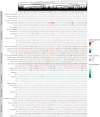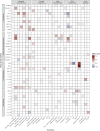Immune changes in pregnancy: associations with pre-existing conditions and obstetrical complications at the 20th gestational week-a prospective cohort study
- PMID: 39696496
- PMCID: PMC11657209
- DOI: 10.1186/s12916-024-03797-y
Immune changes in pregnancy: associations with pre-existing conditions and obstetrical complications at the 20th gestational week-a prospective cohort study
Abstract
Background: Pregnancy is a complex biological process and serious complications can arise when the delicate balance between the maternal and semi-allogeneic fetal immune systems is disrupted or challenged. Gestational diabetes mellitus (GDM), pre-eclampsia, preterm birth, and low birth weight pose serious threats to maternal and fetal health. Identification of early biomarkers through an in-depth understanding of molecular mechanisms is critical for early intervention.
Methods: We analyzed the associations between 47 proteins involved in inflammation, chemotaxis, angiogenesis, and immune system regulation, maternal and neonatal health outcomes, and the baseline characteristics and pre-existing conditions of the mother in a prospective cohort of 1049 pregnant women around the 20th gestational week. We used Bayesian linear regression models to examine the impact of risk factors on biomarker levels and Bayesian cause-specific parametric proportional hazards models to analyze the effect of biomarkers on maternal and neonatal outcomes. We evaluated the predictive value of baseline characteristics and 47 proteins using machine-learning models and identified the most predictive biomarkers using Shapley additive explanation scores.
Results: Associations were identified between specific inflammatory markers and several conditions, including maternal age and pre-pregnancy body mass index, chronic diseases, complications from prior pregnancies, and COVID-19 exposure. Smoking during pregnancy affected GM-CSF and 9 other biomarkers. Distinct biomarker patterns were observed for different ethnicities. Within obstetric complications, IL-6 inversely correlated with pre-eclampsia risk, while birth weight to gestational age ratio was linked to markers including VEGF and PlGF. GDM was associated with IL-1RA, IL-17D, and eotaxin-3. Severe postpartum hemorrhage correlated with CRP, IL-13, and proteins of the IL-17 family. Predictive modeling yielded area under the receiver operating characteristic curve values of 0.708 and 0.672 for GDM and pre-eclampsia, respectively. Significant predictive biomarkers for GDM included IL-1RA and eotaxin-3, while pre-eclampsia prediction yielded the highest predictions when including MIP-1β, IL-1RA, and IL-12p70.
Conclusions: Our study provides novel insights into the interplay between preexisting conditions and immune dysregulation in pregnancy. These findings contribute to our understanding of the pathophysiology of obstetric complications and the identification of novel biomarkers for early intervention(s) to improve maternal and fetal health.
Keywords: COVID-19; Gestational diabetes; Immunology; Pre-eclampsia; Pregnancy; Risk prediction; Women’s health.
© 2024. The Author(s).
Conflict of interest statement
Declarations. Ethics approval and consent to participate: The PREGCO study was approved by the Knowledge Centre for Data Protection and Compliance, the Capital Region of Denmark (P-2020–255), and by the Scientific Ethics Committee of the Capital Region of Denmark (journal number H-20022647). All PREGCO participants provided written informed consent. Danish legislation allows for register-based research to be conducted without the consent of participants and without ethical committee approval. Registry data, i.e., the Danish Medical Birth Registry, was held at Statistics Denmark, which is the Danish national statistical institution. Consent for publication: Not applicable. Competing interests: SB has ownerships in Hoba Therapeutics Aps, Novo Nordisk A/S, Lundbeck A/S, and managing board memberships in Proscion A/S. HSN received personal payment or honoraria for lectures and presentations from Ferring Pharmaceuticals, Merck, Astra Zeneca, Cook Medical, and Ibsa Nordic.
Figures






References
-
- La Rocca C, Carbone F, Longobardi S, Matarese G. The immunology of pregnancy: regulatory T cells control maternal immune tolerance toward the fetus. Immunol Lett. 2014;162 1 Pt A:41–8. - PubMed
-
- Kalagiri RR, Carder T, Choudhury S, Vora N, Ballard AR, Govande V, et al. Inflammation in complicated pregnancy and its outcome. Am J Perinatol. 2016;33:1337–56. - PubMed
-
- Oboho IK, Reed C, Gargiullo P, Leon M, Aragon D, Meek J, et al. Benefit of early initiation of influenza antiviral treatment to pregnant women hospitalized with laboratory-confirmed influenza. J Infect Dis. 2016;214:507–15. - PubMed
MeSH terms
Substances
LinkOut - more resources
Full Text Sources
Research Materials
Miscellaneous

